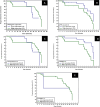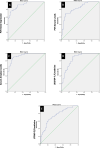Prognostic and diagnostic value of PVR gene and protein levels, serum amylase, and urinary IGFBP-7 and TIMP-2 biomarkers in multiple myeloma
- PMID: 40369504
- PMCID: PMC12080016
- DOI: 10.1186/s12885-025-14241-6
Prognostic and diagnostic value of PVR gene and protein levels, serum amylase, and urinary IGFBP-7 and TIMP-2 biomarkers in multiple myeloma
Abstract
Background: Multiple Myeloma (MM) is a plasma cell malignancy associated with systemic and renal complications. This study evaluates the prognostic and diagnostic significance of poliovirus receptor (PVR) gene expression and protein levels, serum amylase, and urinary biomarkers (IGFBP-7, TIMP-2) in MM patients.
Methods: In a prospective case-control study, 50 MM patients and 50 healthy controls were assessed. PVR gene expression (qPCR), serum PVR and amylase (ELISA/chemistry analyzer), and urinary IGFBP-7 and TIMP-2 (ELISA) were analyzed. Statistical analyses included correlation tests, Kaplan-Meier survival analysis, Cox regression, stratified quartile analysis, and receiver operating characteristic (ROC) curve evaluation. Multiple testing corrections (Bonferroni and FDR) were applied.
Results: MM patients showed significantly elevated PVR expression and protein levels, serum amylase, and urinary biomarkers compared to controls (p<0.001). High PVR expression was associated with advanced disease stage, TP53 mutations, and reduced overall survival (OS: 44.84 vs. 48.0 months; p=0.044). High serum amylase and urinary IGFBP-7 were linked to significantly poorer OS and progression-free survival (PFS). Multivariate Cox regression confirmed PVR expression (HR=12.2), serum amylase (HR=11.5), and IGFBP-7 (HR=11.9) as independent predictors of poor OS, findings that remained robust in bootstrapped and penalized regression models. Stratified analysis revealed that patients in the highest biomarker quartiles had significantly worse outcomes and higher TP53 mutation rates. ROC analysis showed excellent diagnostic performance for the combined panel (PVR + amylase + IGFBP-7; AUC=0.97, sensitivity =90%, specificity = 88%), outperforming individual markers. Significant associations remained after multiple testing correction.
Conclusion: PVR gene expression, serum amylase, and urinary IGFBP-7 are independent and robust prognostic biomarkers in MM. Their combined use enhances diagnostic accuracy and risk stratification, supporting their integration into clinical decision-making. Validation in larger, multi-center studies is recommended. Limitations include the single-center design, modest sample size, absence of disease comparator groups, and the cross-sectional nature of biomarker evaluation. These findings warrant validation in larger, multi-institutional, and longitudinal studies.
Keywords: IGFBP-7; Multiple myeloma; PVR gene expression; Prognostic biomarkers; Risk stratification; Serum amylase; Survival analysis; TIMP-2.
© 2025. The Author(s).
Conflict of interest statement
Declarations. Ethics and approval consent to participate: Ethical approval was gained according to The Scientific Research Ethics Committee of Kafr Elsheikh University, Egypt, Approval #: KFSIRB200-396. All subjects were informed and gave their voluntary, written informed consent. It is declared that: All methods were carried out by relevant guidelines and regulations. It was performed according to the recommendations of Good Clinical Practice and the Declaration of Helsinki (2013). Consent for publication: N/A Competing interests: The authors declare no competing interests.
Figures



Similar articles
-
The Ratio of Serum Urea Nitrogen to Albumin Is a Better Predictor of Overall Survival in Multiple Myeloma Patients than Urea Nitrogen Alone.Acta Haematol. 2025;148(1):36-47. doi: 10.1159/000538479. Epub 2024 Mar 25. Acta Haematol. 2025. PMID: 38527425 Free PMC article.
-
The diagnostic and prognostic values of circulating miRNA-1246 in multiple myeloma.Hematology. 2022 Dec;27(1):778-784. doi: 10.1080/16078454.2022.2095890. Hematology. 2022. PMID: 35793786
-
Urinary cell cycle arrest proteins urinary tissue inhibitor of metalloprotease 2 and insulin-like growth factor binding protein 7 predict acute kidney injury after severe trauma: A prospective observational study.J Trauma Acute Care Surg. 2020 Oct;89(4):761-767. doi: 10.1097/TA.0000000000002864. J Trauma Acute Care Surg. 2020. PMID: 33009198 Free PMC article.
-
Urinary Tissue Inhibitor of Metalloproteinase-2 (TIMP-2) • Insulin-Like Growth Factor-Binding Protein 7 (IGFBP7) Predicts Adverse Outcome in Pediatric Acute Kidney Injury.PLoS One. 2015 Nov 25;10(11):e0143628. doi: 10.1371/journal.pone.0143628. eCollection 2015. PLoS One. 2015. PMID: 26606754 Free PMC article.
-
Circulating plasma cells as a predictive biomarker in Multiple myeloma: an updated systematic review and meta-analysis.Ann Med. 2024 Dec;56(1):2338604. doi: 10.1080/07853890.2024.2338604. Epub 2024 Apr 10. Ann Med. 2024. PMID: 38599340 Free PMC article.
References
-
- Cowan AJ, Green DJ, Kwok M, Lee S, Coffey DG, Holmberg LA, Tuazon S, Gopal AK, Libby EN. Diagnosis and management of multiple myeloma: a review. Jama. 2022;327(5):464–77. - PubMed
-
- Rajkumar SV, Dimopoulos MA, Palumbo A, Blade J, Merlini G, Mateos MV, Kumar S, Hillengass J, Kastritis E, Richardson P, Landgren O. International Myeloma Working Group updated criteria for the diagnosis of multiple myeloma. The Lancet oncology. 2014;15(12):e538-48. - PubMed
MeSH terms
Substances
LinkOut - more resources
Full Text Sources
Medical
Research Materials
Miscellaneous

